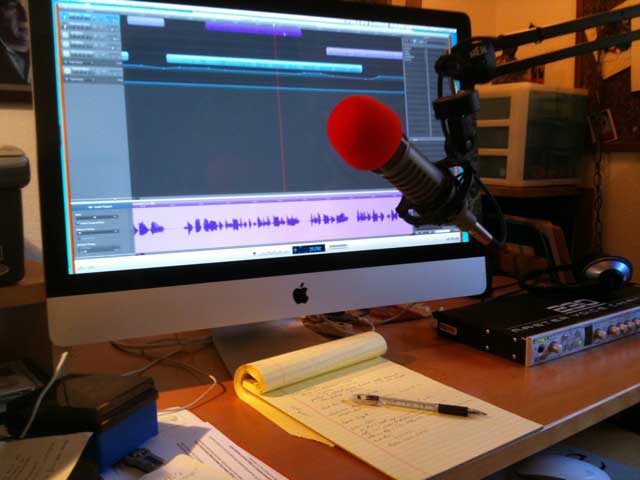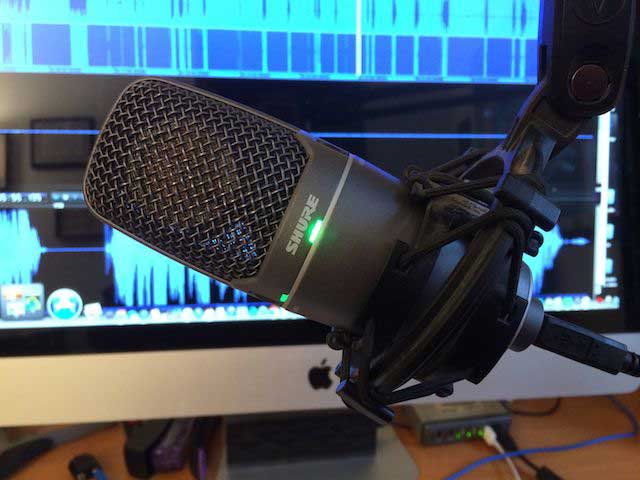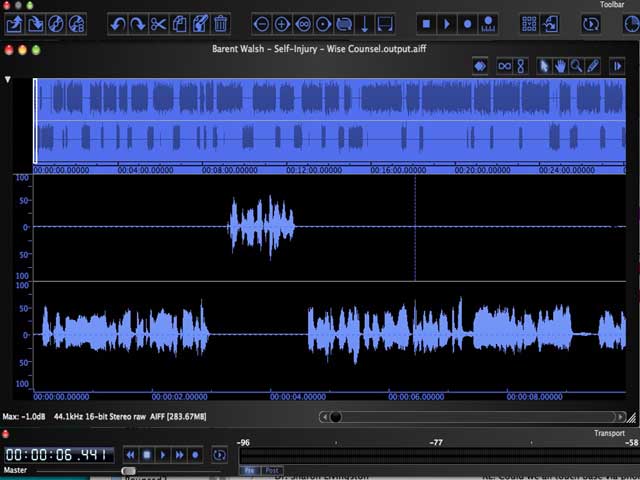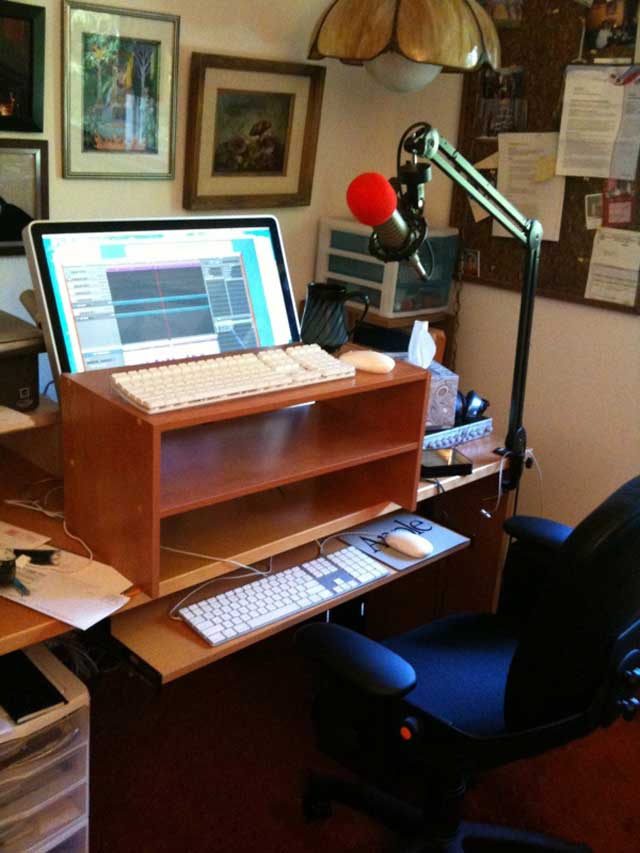Shrink Rap Radio
All the psychology you need to know and just enough to make you dangerous.

My Podcasting Setup

Listeners who want to create their own podcasts sometimes ask about my setup. The photo below shows the former state of things at Chez Shrink: ______________________________ November 2016 UPDATE I’ve upgraded my mic to the more expensive ElectroVoice RE-320. I wonder if listeners will be able to notice any difference. I think it will do a better job of rejecting background noise and that my breathing won’t be so audible. The first episode of using this new mic is #533.
READ MORE
July 2016 UPDATE I’ve used several different mics over the past 11 years but the one I’m using lately is an Audio-Technica ATR2100 which costs all of about $60 on Amazon and works as well as mics I have had in the past that were more than $300! I’m running that mic into a small, inexpensive mixer, the 4 channel Mackie mixer http://tinyurl.com/nwkytv6 which sells for $99. I go into the mixer with the XLR cable that comes with the ATR mic and I go out from the mixer into an iMic so that I have a USB plug that goes into the Mac http://tinyurl.com/lsnkwxz. I use Piezo, Mac software from Rogue Amoeba, currently $19, to make a stereo recording of the person I’m interviewing on Skype. I use an audio editing program Amadeus Pro to edit the audio interview. You could use the free program Audacity which is easy to find online and lots of tutorials on Youtube. From there, I put all the different audio pieces (e.g. intro music, etc.) together using Garageband and then send the final product to iTunes. Also, I’ve recently begun adding video to the process. I’m using the built-in camera on my iMac and conducting the interview on Skype. I record the video using Call Recorder the software program by Ecamm. I do minor editing of the video using Apple’s iMovie software. You can find these videos on Youtube by going there to shrinkrapradio1. __________________________ Back in February 2014 I had decided to downsize and simplify my operation, thereby freeing up desk space and generating cash with the high-quality gear I sold on eBay. That cash will go toward upgrading my 2009 vintage iMac to the latest model. I sold off the Aphex Master Voice Channel 230 (the box you see on the bottom right) and the ElectoVoice RE20 mic). I don’t think you’ll hear a difference, at least not one that matters! Here’s what the setup looks like as of February 2014.

The photo above will give you an idea of my present physical set up. You see an iMac running the audio editor, Bias Peak Pro 7 (unfortunately, no longer available). You see my recently acquired Shure PG42 USB Condenser mic on a flexible mic boom. The mic cable goes into a USB port on my 27″ iMac. Part of the fun for me in podcasting is experimenting with equipment! My equipment has evolved over the nine years during which I’ve been podcasting. It can be done for a lot less than I’ve spent.
READ MORE
Most podcasters are probably using a mixer to balance the inputs (e.g. mic and phone). I used to do that but I had all sorts of problems getting the setup just right, as my early podcasts will reveal. Once I got rid of the mixer and used the current setup, my sound has been all that I could hope for. Most of my interviews are conducted over the phone, using Skype. I digitally capture and record both sides of the conversation using Rogue Amoeba’s Piezzo (recording software for the Mac that’s only $10 and let’s me get my voice and my Skype guest on separate audio tracks for editing!). I save the file in AIFF format and then open it in BIAS Peak Pro 7, a wonderful but no longer availaable, high-end audio editor that, among other things, allows me to fix places where my guest and I are talking at the same time, by substituting silence for one or the other of us.

I also use Sound Soap 3 which can be integrated into Peak Pro 7 Â (as well as Garageband, which I also use) as a separate plug-in to eliminate any background noise. Sound Soap 3 makes noise elimination simple and automatic. All I have to do is select a few seconds worth of noise where nobody is speaking and Sound Soap 3 will memorize that background noise with a single button click and then take it out of the rest of the track. It’s also available as a standalone program. I save the file as a .aiff out of Peak Pro 6 and then drag that file to The Levelator to ensure that the gain levels are more or less equal. From there, I bring the file into Garageband where I edit and add the other show components, e.g. music, jingles, etc. That file is then saved as an MP3 and uploaded to the server where my podcast is hosted.
READ MORE
If you want to conduct phone interviews, the first thing is to get a Skype account and get comfortable with it. You can call people across the glove for free if you and they are both on Skype. If you want to interview someone who is not on Skype, for a small fee, Skype lets you call out to regular phones. If you already have a USB microphone or your computer has a built-in mic, you can use that. You may need to also use earphones to prevent feedback. Many people use an inexpensive headset (earphone and mic combo). You will need one that has a USB connector to get it into the computer and working with Skype. There are some recommended models on the Skype site, I believe. Click here to see a very authoritative slide show on configuring Skype for Phone Interviews by Doug Kaye and Paul Figgiani. This slide presentation is what inspired my move to  Peak Pro 7 and The Levelator which I described above. I figured, if it’s good enough for these pros, it’s good enough for me! ________________ So much sitting is bad for my back! I’ve developed an alternative that will let me work from a standing position for at least some of the time. The iMac monitor is tall enough that I can still see it from a standing position by tilting it up, without having to raise it. I can put a portable bookshelf from Target on top of my desk and use a wireless keyboard and mouse on top of that, without having to reposition my regular keyboard and mouse. Here’s a photo of this setup.

My setup is admittedly “Mac-centric.” Some time back, I received an inquiry from someone using a Windows PC, looking for an inexpensive way to get into podcasting, using phone interviews. Here’s what I suggested: Get yourself a Skype account (www.Skpe.com). You’ll conduct your interviews by calling folks on their regular phones using Skype on your computer. Get a USB headset (earphone(s) and mic) which you’ll use for these Skype calls. Next, you need to be able to record your calls digitally. For this, purchase a copy of Pamela Recorder for Skype. You can find it online. Not expensive. Set up Pamela to record in .wav format. Download a copy of Levelator. (Google it) Drag your .wav file onto the Levelator icon. This will improve your sound levels.
READ MORE
Next, you need software for editing your interview, and perhaps adding music or other sound elements. Many people use the free software program, Audacity. Or you might prefer to spend some money and get a program with an easier to learn interface than what is offered by Audacity. I found a Windows multitrack audio editing program that looks like it was made to look like and work like the Mac’s Garageband. It’s called Mixcraft. They have a free download, which they say is fully functional. And the cost is only $64.95 where other similar programs can cost more than $1,000. So download the free version and see what you think. Finally, you will need to have an online place to host your podcasts. You need a blog. I would suggest you use WordPress. Also, take a look at libsyn.com as a possible place to host your podcasts, which you will have saved in .mp3 format.